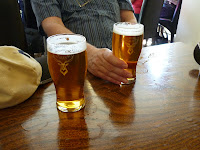Easter Sunday was a quiet day - my parents had agreed to ring for a couple of church services, but I had no such committments, so had the kind of day which starts with tea in bed, and moves on to eating breakfast in pyjamas while watching Doctor Who, and then drifts onward to involve sitting around in the sunshine with a Golden Age detetive novel and a cat.
Later, we had a deicious Sunday roast: Roast beef, Yorkshire pudding, roast potatoes and runner beans, with gin and tonic before hand, and red wine to accompany it, and lemon merienge pie and fresh coffee to follow. It was all delicious, and very relaxed and civilized..
 |
| looking West towards Combe Martin |
So on Monday we decided to be a little more energetic, and to go for a walk.
We started near Trentishoe which is on the edge of the Exmoor National Park, and walked along the top of the cliffs.
It was another gloriously sunny day, and amazingly still, too, so that even on the top of the cliff there was virtually no wind, and no sound, either, other than the distant sound of the sea, the bird-song and the calls of the sheep and their lambs, grazing along the cliff top.
Heddon Valley to Heddon's Bay |
It's a fairly harsh environment - the grass is short and sheep-cropped, and the other plant-life mainly consists of bracken, heather and gorse.
The gorse is all in flower at present, profligate with it's bright gold flowers. The bracken is bright green with new growth, and the heather still has faded white flowers. There are a few foxgloves growing against the drystone walls, a few of them starting to show pinkish buds but the majority with nothing, yet, but large, furry leaves. (I was pleasantly surprised to find that I had managed to correctly identify them as foxgloves, even without the flowers - unlike my mother, I don't know much about plants)
| Looking up Heddon Valley to Hunter's Inn |
The soil is too poor, and there is too much wind and salt to allow many larger trees to flourish, but that does mean you can see forever, along the headlands.
After a little while, we parted company; my mum turning back the way we'd come (which was relatively flat, andfairly easy going) while my dad and I continued along the path, which got much steeper as it continued around the headland, with some more stunning views, this time eastward toward Lynmouth. The path then turns inland, at the Heddon Valley.
The valley is very steep and narrow, and the path runs along one side of it, working it's way back downhill from the top of the cliffs, down towards the river which runs along the valley into the sea. F|rom above, you can see the tiny, rocky inlet where the river reaches the sea. there is a tiny, shingled beach, and lots of rocks.
 |
| Bluebells |
We didn't go down to the sea, but instead continued down the side of the valley. As the path decended, we gradually left behind the heather and gorse, and started to see many wild violets, primroses and, as we came among the trees, bluebells, vast drifts of them.
Most of the trees were birch, beech nd young oaks, all of them bright with new growth.
Most of the trees were birch, beech nd young oaks, all of them bright with new growth.
As we reached the bottom of the valley, we found ourselves walking by the side of the river, which is cold, and clear, and surrounded by beech trees, with primroses and white campion and ragged robin all growing along the banks.
 We arrived at the Hunter's Inn about 10 minutes after my mum (who had returned to the car and driven it round to meet us) did.
We arrived at the Hunter's Inn about 10 minutes after my mum (who had returned to the car and driven it round to meet us) did.
Coming down from the cliffs and woods it's a little startling to come upon a beautifully manicured lawn and a set of peacocks..
One of the nice things about going for a vigourous walk is that when you reach the pub at the end you do tend to feel that you have earned your beer!
 |
| Axe, coming intoWoody Bay Station |
After enjoying our beer, and some very late lunch, we hedd home, via Woody Bay Station - this is a station on what was once (and hopes one day to be again) the Lynton to Barnstaple narrow-guage railway. The railway opened in about 1898, originlly built and run by a private company, over a distance of bout 19 miles. It was tasken over by Southern Railways in the 1920s and closed in 1935.
A small part of the railway has been restored and reopened, and it is now possible to go for a short train-ride (about 1 mile each way, I believe)
The railway was running, so we went and had a look at their displays, and watched the train leaving and returning, making little 'pish-te-cuff' noises just like Ivor the Engine, nd mking that distinctive, Steam-engine smell of hot metal and cinders.
In it's hey-day, the railway ran through the village my parents now live in, and the current Trust hope one day to restore the entire 19 miles of track.



1 comment:
Sounds wonderful! Oh, to be in Europe...
Post a Comment